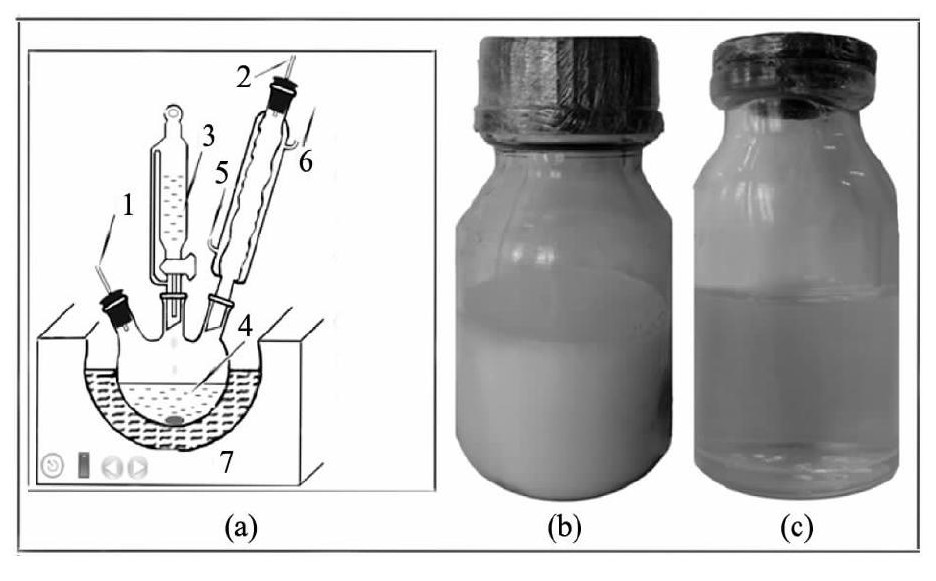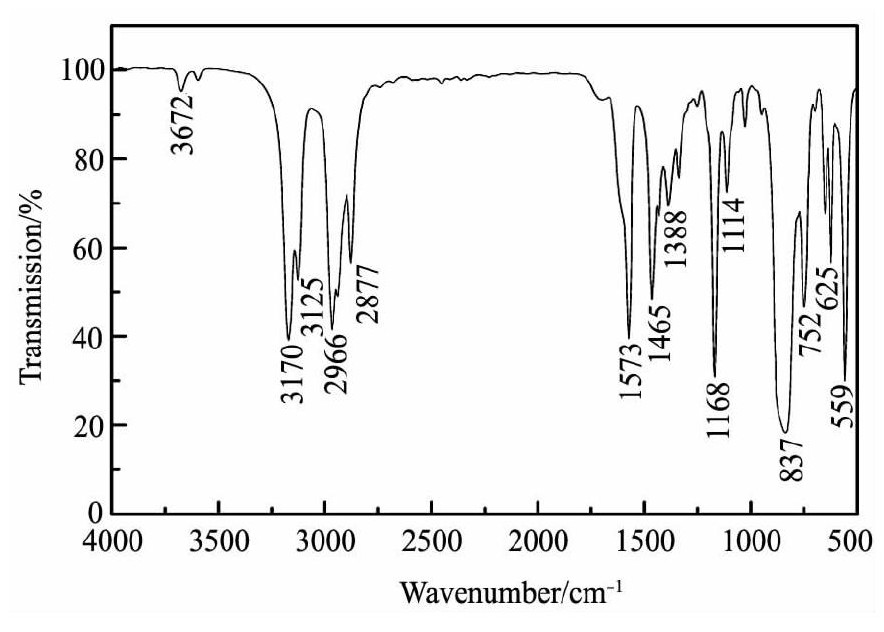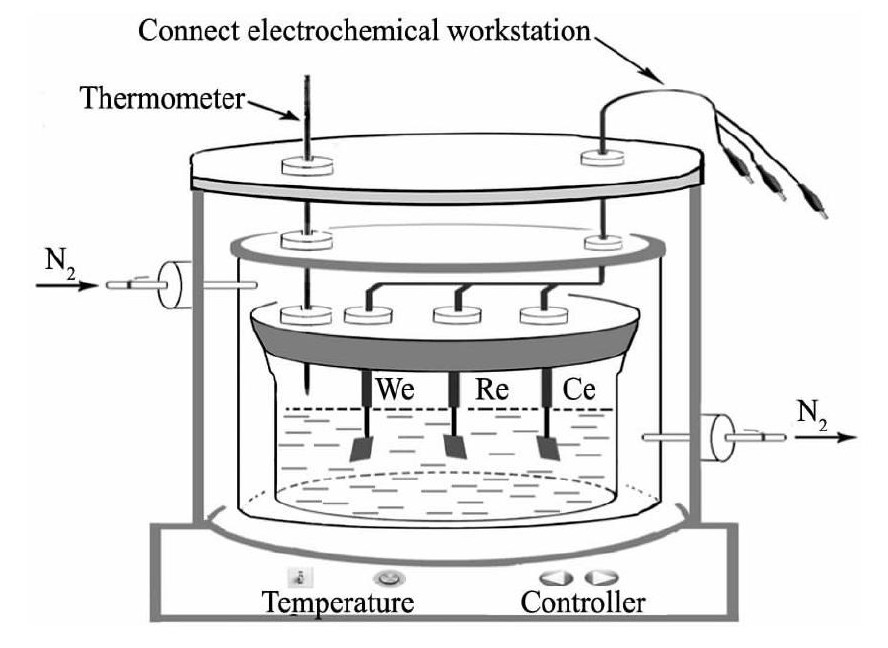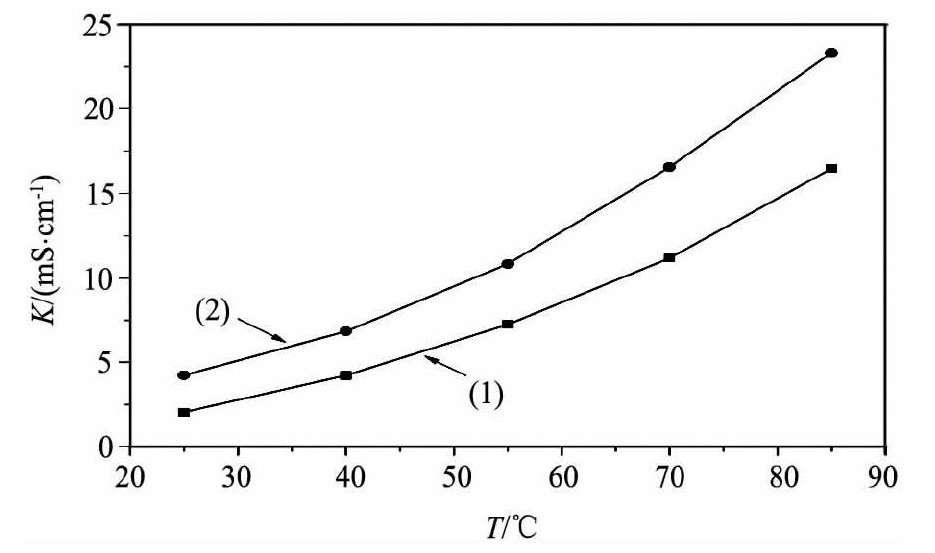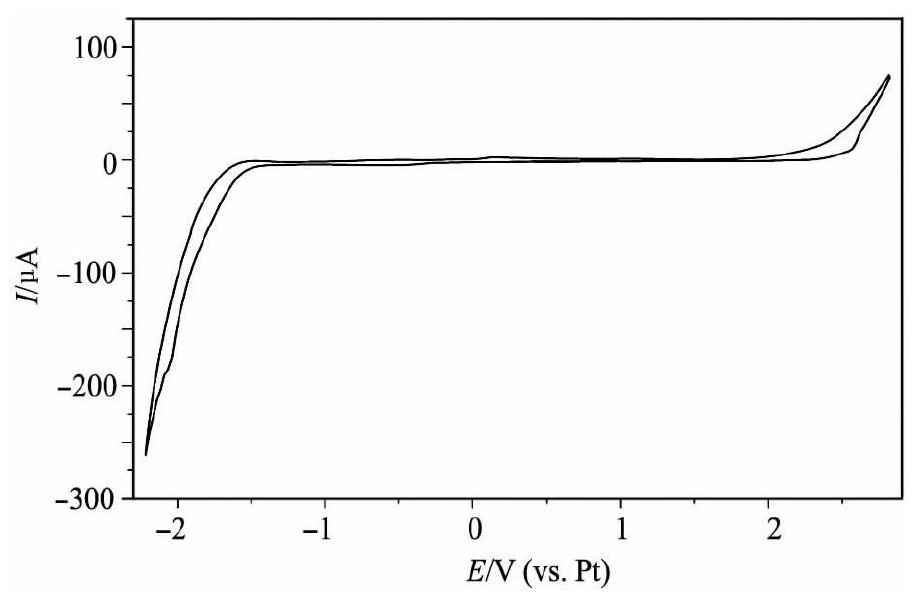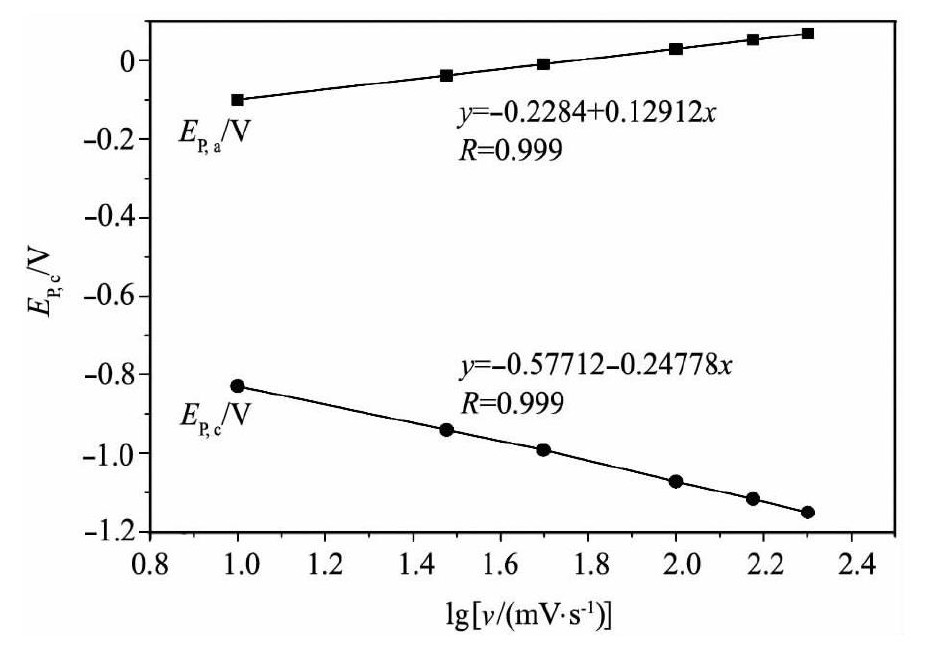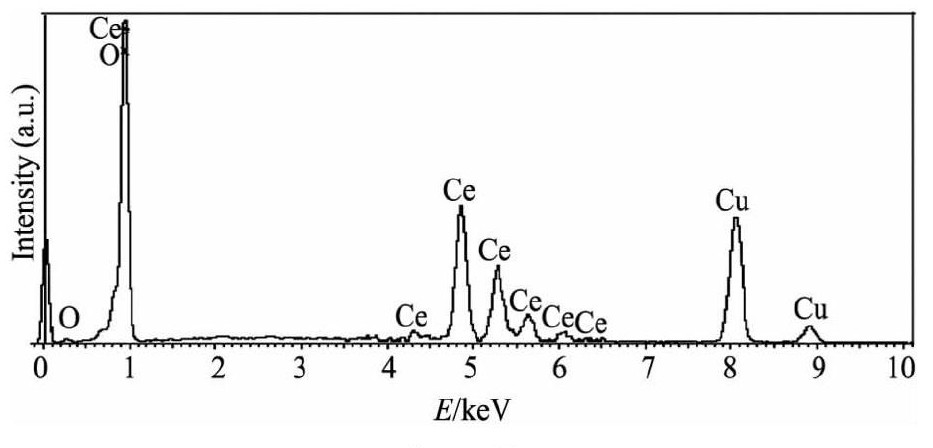离子液体中铈的电沉积行为
新疆大学化学化工学院
摘 要:
以一氯丁烷、N-甲基咪唑和KPF6为原料合成了1-丁基-3-甲基咪唑六氟磷酸盐离子液体 ([BMIM]PF6) , 用红外光谱 (IR) 法对合成的[BMIM]PF6进行了结构分析。用循环伏安法分别测试了[BMIM]PF6的电化学窗口和在[BMIM]PF6中加入乙二醇 (EG) 和CeCl3形成的体系 ([BMIM]PF6-EG-CeCl3) 中Ce (III) 的电化学行为。结果表明, 在80℃时[BMIM]PF6的电化学窗口为4.0 V, [BMIM]PF6-EG-CeCl3体系中Ce (III) 的电沉积是受扩散控制的不可逆电极过程, 此过程传递系数α为0.05, 扩散系数D0为2.45×10-6cm2·s-1。通过扫描电镜 (SEM) 观察了Ce在Cu片表面上电沉积层的形貌, 发现随着沉积电势的增加, 金属铈镀层的颗粒呈从小到大的变化规律。用X射线能量色散谱 (EDS) 分析了该电沉积层成分发现电沉积镀层为纯金属铈及其氧化物。
关键词:
中图分类号: O646
作者简介:玉山江·哈斯木 (1980-) , 男, 维吾尔族, 新疆阿克苏乌什县人, 硕士研究生, 研究方向:材料物理化学;E-mail:1316273851@qq.com;;刘瑞泉, 教授;电话:0991-8582887;E-mail:liu.rq@163.com;
收稿日期:2013-04-11
基金:新疆维吾尔自治区高校科研计划项目 (XJEDU2012I05);国家自然科学基金项目 (21063013) 资助;
Electrodeposition Behaviors of Cerium in Ionic Liquid
Yushanjiang Hasimu Liu Ruiquan Mi Hongyu
College of Chemistry and Chemical Engineering, Xinjiang University
Abstract:
The 1-butyl-3-methylimidazolium hexafluorophosphate ( [BMIM]PF6) ionic liquid was synthesized by 1-Chlorobutane, NMethylimidazole and KPF6. The structure of ionic liquid was investigated by infrared ( IR) spectrum. The electrochemical windows of[BMIM]PF6 and the electrochemical behaviors of Ce ( III) in [BMIM]PF6 containing ethylene glycol ( EG) and CeCl3 ( [BMIM]PF6-EG-CeCl3) were studied by cyclic voltammetry. The results indicated that the electrochemical window of[BMIM]PF6 was 4. 0 V and the electrodeposition of Ce ( III) from [BMIM]PF6-EG-CeCl3 was controlled by diffusion and irreversible growth process at 80 ℃. The cathodal transfer coefficient ( α) and diffusion coefficient ( D0) of Ce ( III) in[BMIM]-PF6-CeCl3-EG were: α = 0. 05, D0= 2. 45 ×10- 6cm2·s- 1. The surface morphology of Ce electrodeposited on copper foil was characterized by means of scanning electron microscopy ( SEM) . The results indicated that the size of electrodeposit increased with cathodic potentials increasing. The composition of Ce was analyzed by energy dispersive spectroscope ( EDS) and the results indicated that the surface electrodeposit was pure cerium and its oxide.
Keyword:
cerium; ionic liquid; cyclic voltammetry; electrochemical windows; electrodeposition;
Received: 2013-04-11
虽然稀有金属元素一般属于非必需元素, 但它们在特殊功能合金材料的研究和生产[1], 医疗科学研究[2], 核电新能源研究[3], 燃料电池[4]等领域中具有非常重要的作用和广泛的用途。随着现代工农业的发展, 对稀有金属的需求量也不断增大。金属铈 (Ce) 作为最丰富的稀土元素, 具有独特的物理和化学性质, 在环境净化材料、环境降解材料、能源脱硫、脱硝、汽车尾气净化、光催化、石油化工、可降解塑料等环境保护领域和钢铁、有色金属及其合金、发火合金、永磁材料及贮氢材料等[5]工业领域中应用广泛。传统的金属铈的生产工艺主要是用铈的氯化物或氧化物与氯化钾等盐类按一定比例配制二元电解质体系, 该二元电解质体系在高温熔化并经高电流电解而获得金属铈, 此工艺存在能耗高、污染环境和生产工艺流程复杂等缺点[6]。离子液体作为新一代的绿色溶剂正日益受到人们的重视, 与普通的溶剂相比, 离子液体具有蒸汽压低、热稳定性好、电化学稳定性高、导电性能好和电化学窗口较宽等特点[7,8,9], 可用于材料制备[10]、催化反应[11]、金属电沉积[12]、萃取分离[13]和生物工程[14]等各个领域, 因此, 不少科研工作者利用离子液体的特点, 开展了在离子液体中电化学沉积半导体金属或沉积一些在水溶液中比较难沉积的金属及其合金。
自从Wilkes等[15]报道了将氯化1-甲基-3-乙基咪唑 (1-ethyl-3-methylimi dazoliumchloride, EMIC) 与Al Cl3混合可得到性能优良的室温离子液体后, EMIC-Al Cl3型离子液体在电沉积金属方面得到了广泛的应用。人们以EMIC-Al Cl3为电解液研究了Zn, Sn, Ga, Ti, Cu-Al, Co-Al等金属及合金的电沉积[16,17,18,19,20,21,22]。传统的金属铈的生产工艺已经研究的比较深入, 应用也比较广泛, 然而, 在离子液体中电沉积金属铈的研究却相对较少。目前, 文献中报导的主要是在[BMIM]Cl-Al Cl3-Ce Cl3或[Me3NBu][TFSI]-[HTFS]-Ce (CO3) 3·x H2O电解液体系中的金属铈的电沉积。Lisenkov等[23]研究了[BMIM]Cl-Al Cl3-Ce Cl3电解液体系中当Al3+在1.5和1.7 (摩尔比) 时在AA2024表面得到了AlCe合金镀层, 讨论了电解液的电化学行为和Al Cl3浓度对镀层的影响。David等[24]研究了[Me3NBu][TFSI]-[HTFS]-Ce (CO3) 3·x H2O体系中金属铈的电沉积, Pt, Au和GC (玻碳电极) 作为工作电极, 采用循环伏安法研究了电解液的电化学行为, 在Au表面上得到的金属铈的镀层进行了SEM和EDS测试。从目前的研究看, 在[BMIM]Cl-Al Cl3-Ce Cl3或在[Me3NBu][TFSI]-[HTFS]-Ce (CO3) 3·x H2O离子液体电解液体系中一般得到的是金属铈的合金镀层, 很难得到纯铈镀层。想要得到纯的金属铈镀层, 就尽量避免在电解液中加入其他金属盐类。本文从[BMIM]PF6-Ce Cl3-EG体系中直接对电沉积纯金属铈开展研究。
1 实验
1.1 材料及试剂
实验材料及试剂见表1。
1.2 1-丁基-3-甲基咪唑六氟磷酸盐离子液体 ([BMIM]PF6) 的合成
该化合物参照文献[25]合成:其结构如图1所示。
1.2.1中间体1-丁基-3-甲基咪唑氯化盐 ([BMIM]Cl) 的合成
在氮气保护下, 在配有冷凝管和滴液漏斗的1000 ml三口烧瓶中加入100 ml (1.27 mol) 重蒸后的N-甲基咪唑 (如图2 (a) 所示) , 在40℃恒温搅拌条件下, 缓慢滴加140 ml (1.33 mol) 新蒸的1-氯丁烷 (大约在1 h内滴加完) 。滴加完毕后, 在搅拌条件下40℃恒温反应1 h, 然后逐步升温至80℃, 恒温搅拌反应72 h。将体系冷却至室温, 反应液加适量水溶解, 用分液漏斗除去上层未反应的原料等有机相物质后, 用旋转蒸发仪70℃减压蒸馏除水, 在70℃真空干燥12 h, 得到淡黄色粘稠液体。将该液体降温, 随着温度下降, 开始出现白色颗粒状物, 至室温时逐渐变为白色固体 (如图2 (b) 所示) , 产率为90%。
表1 实验材料及试剂Table 1 Regents and materials used in experiments 下载原图

表1 实验材料及试剂Table 1 Regents and materials used in experiments
图1[BMIM]PF6离子液体的合成Fig.1 Synthesis of[BMIM]PF6ionic liquid
图2[BMIM]Cl离子液体的合成装置图 (a) , [BMIM]Cl (b) , [BMIM]PF6离子液体 (c) Fig.2 Schematic diagram of synthesis of[BMIM]Cl ionic liq-uid apparatus (a) , [BMIM]Cl (b) , [BMIM]PF6i-onic liquid (c)
1-Nitrogen inlet;2-Nitrogen outlet;3-1-chlorobutane;4-N-methylimidazole;5-Water inlet;6-Water outlet;7-Constant temperature magnetic stirrer
1.2.2 1-丁基-3-甲基咪唑六氟磷酸盐离子液体 ([BMIM]PF6) 的合成
在一个500 ml烧杯中加入200 ml超纯水, 将合成的中间体 ([BMIM]Cl) 全部加入并在25℃条件下搅拌使其溶解, 制得[BMIM]Cl的水溶液;在另一个装有800 ml超纯水的2 L烧杯中倒入100 g KPF6, 25℃条件下搅拌使KPF6固体完全溶解后, 把[BMIM]Cl的水溶液缓慢滴加到KPF6的溶液中 (保持搅拌) , 滴加完毕后, 在25℃继续搅拌反应24 h, 反应过程中有乳白色油状物不断产生。待反应完成后, 静置, 将上层的水相弃去, 下层的油状物质用超纯水反复清洗 (洗至上层水相中加入Ag NO3溶液无沉淀产生为止) , 将清洗后的油状物质70℃减压旋蒸, 70℃真空干燥24 h即得到无色透明粘稠的1-丁基-3-甲基咪唑六氟磷酸盐 ([BMIM]PF6) 离子液体 (如图2 (c) 所示) , 产率为85%。
1.3 离子液体[BMIM]PF6的红外吸收光谱分析
离子液体[BMIM]PF6的红外光谱图如图3所示。
图3中752 cm-1是丁基的C-H吸收峰, 837, 3672 cm-1分别为P-F键的弯曲振动和伸缩振动吸收峰, 1388 cm-1是甲基的变形振动吸收峰, 1465, 1573 cm-1是咪唑环骨架振动吸收峰, 2877, 2966 cm-1是甲基C-H的伸缩振动吸收峰, 3125, 3170 cm-1是咪唑环上C-H伸缩振动吸收峰。从红外图谱分析可知, [BMIM]PF6成功合成[26]。
图3[BMIM]PF6离子液体的红外光谱图Fig.3 IR spectrum of[BMIM]PF6ionic liquid
1.4 电解液[BMIM]PF6-EG-Ce Cl3的配制
电解液的配制是在充满氮气的手套箱内进行, 取5 ml真空干燥后的[BMIM]PF6离子液体, 加入2 ml乙二醇 (EG) , 使之全部溶解, 再加入1 g无水氯化铈 (Ce Cl3) , 70℃磁力搅拌24 h得到黄色的[BMIM]PF6-EG-Ce Cl3电解液。
1.5[BMIM]PF6和[BMIM]PF6-Ce Cl3-EG的电导率测试
选用DJS-IC型电导电极 (上海精密科学仪器) 和DDSJ-308A (上海精密科学仪器) 型电导率仪进行测试。测试温度范围为25~85℃。
1.6[BMIM]PF6和[BMIM]PF6-EG-Ce Cl3的循环伏安 (CV) 测试
以面积为0.5 cm×0.5 cm的铂片作为工作电极, 以直径为0.5 mm的铂丝电极为参比电极, 213型铂电极作为对电极进行[BMIM]PF6和[BMIM]PF6-EG-Ce Cl3的循环伏安 (CV) 测试。每次测量前, 电极用金相砂纸打磨, 并依次于硝酸、氢氧化钠、丙酮、二次蒸馏水中各超声洗涤5 min, 干燥后备用。
Ce (III) 在铜片表面上的恒电势电沉积测试:以面积为1 cm×1 cm的铜片作为工作电极, 直径为0.5 mm的铂丝为参比电极, 213型铂电极为对电极。铜片处理采用常规的碱性除油, 用20%HCl水溶液酸洗, 水和无水乙醇洗, 干燥后使用。电沉积后, 从电解液中取出试样, 用丙酮和二次蒸馏水小心地将附着的液体洗去, 吹干。
以上均用德国IM6 (ZAHNER&ZENNIUM) 公司生产的电化学综合测试仪在氮气保护条件下对系统进行电化学测试, 用电子调温控温仪控温, 操作温度均为 (80±2) ℃。实验装置图如图4所示。
图4 电化学测试实验装置图Fig.4 Schematic diagram of electrochemical tests apparatus
1.7 铜表面Ce镀层的形貌与元素分析
采用剑桥S-360型扫描电镜和剑桥Inca X-Max型X射线能量色散谱仪对电沉积层进行微观形貌和成分分析。
2 结果与讨论
2.1[BMIM]PF6, [BMIM]PF6-Ce Cl3-EG的电导率测试
不同温度下[BMIM]PF6和[BMIM]PF6-Ce Cl3-EG的电导率 (K) 如图5所示, 由图5可见, [BMIM]PF6和[BMIM]PF6-Ce Cl3-EG的电导率 (K) 值均随温度升高而升高, 并且相同温度下[BMIM]PF6-Ce Cl3-EG的电导率大于[BMIM]PF6的电导率。这表明温度升高有利于电解液内正负离子的扩散, 能促进传质速率, 有利于金属电沉积。本实验中选80℃为实验温度。
图5 不同温度下[BMIM]PF6和[BMIM]PF6-Ce Cl3-EG的电导率Fig.5Electrical conductivities of[BMIM]PF6and[BMIM]PF6-Ce Cl3-EG at different temperatures
(1) [BMIM]PF6; (2) [BMIM]PF6-Ce Cl3-EG
2.2[BMIM]PF6的电化学窗口
电化学窗口是物质从开始发生电化学氧化反应到开始发生电化学还原反应时的电势的差值。电化学窗口越宽, 说明电解液的电化学稳定性越好。离子液体的特性之一就是具有较宽的电化学窗口。在80℃, 以面积为0.5 cm×0.5 cm的铂片作为工作电极, 以直径0.5 mm的铂丝作为参比电极, 以213型铂电极作为对电极构成三电极体系, 扫描速率为50 m V·s-1条件下采用循环伏安法对[BMIM]PF6离子液体进行了电化学窗口测试, 结果如图6所示。由图6可见, 在80℃时, [BMIM]PF6在2.5~-1.5 V区间内电化学性质稳定, 电化学窗口大约4.0 V, 并且在此范围内没有任何明显的杂峰和水峰, 这说明[BMIM]PF6离子液体中杂质较少和水含量也比较低, 满足实验要求。
2.3 扫描速率对循环伏安 (CV) 曲线的影响
在80℃条件下, 以面积为0.5 cm×0.5 cm的铂片作为工作电极, 以直径0.5 mm的铂丝作为参比电极, 以213型铂电极作为对电极构成三电极体系, 采用不同扫描速率, 用循环伏安法 (CV) 对[BMIM]PF6-Ce Cl3-EG电解液体系进行CV测试, 如图7所示。
由图7可见, 尽管扫描速率ν发生变化 (在10~200 m V·s-1范围内) , 但阴极极化曲线中只出现一个还原峰, 这说明, 在电解液中Ce (III) 在Pt工作电极表面还原成Ce (0) 过程是一步还原过程, Ce3++3e=Ce, 即Ce (III) 在阴极一步得到3个电子还原成Ce (0) 的过程。由图7还可知, 随着扫描速率ν的增大 (从10~200 m V·s-1) , 还原电势峰 (EP, c/V) 向负电势方向移动 (从-0.88~-1.15 V) 。理论认为, 对于可逆电极反应, 峰值电势 (EP, c/V) 与扫描速率 (ν) 无关, 而在[BMIM]PF6-Ce Cl3-EG电解液体系中峰值电势 (EP, c/V) 随扫描速率 (ν) 变化而变化, 表明在[BMIM]PF6-Ce Cl3-EG电解液体系Ce电沉积过程属于不可逆过程[27]由阴极极化曲线所得到的数据及相应的计算结果列于表2中。以峰电势对扫描速率的对数作图 (EP/V~lgν) 如图8所示。由图8可见, EP, c/V~lgv和EP, a/V~lgv具有较好的线性关系, 此结果进一步表明在[BMIM]PF6-Ce Cl3-EG电解液体系中Ce的电沉积过程属于不可逆过程[28]。
图6[BMIM]PF6离子液体的电化学窗口Fig.6 Electrochemical window of[BMIM]PF6
图7 80℃时Pt电极上[BMIM]PF6-Ce Cl3-E的CV曲线Fig.7 Cyclic voltammogram for[BMIM]PF6-Ce Cl3-EG, at 80℃
表2 不同扫描速率下的循环伏安曲线数据Table 2 Date of CV with various scan rates 下载原图

表2 不同扫描速率下的循环伏安曲线数据Table 2 Date of CV with various scan rates
图8 80℃, 电沉积金属铈的峰电流EP和lgv关系图Fig.8 Peak potential EPvs.lgv for electrodeposition cerium at 8 0℃
离子的电沉积过程可分为扩散过程和电极反应过程两部分。为进一步探究Ce (III) 在[BMIM]PF6-Ce Cl3-EG电解液体系中的电化学行为, 分别以阴极峰电流和阳极峰电流 (IP, c, IP, a) 的绝对值对扫描速率的平方根 (ν1/2) 作图如图9所示。由图9可知, 峰电流 (IP, c和IP, a) 与扫描速率ν1/2呈线性关系, 这表明在[BMIM]PF6-Ce Cl3-EG电解液体系中Ce (III) 还原成Ce (0) 的过程是受扩散控制的过程。总结以上分析可得出以下结论:在[BMIM]PF6-Ce Cl3-EG电解液体系中Ce (III) 还原成Ce (0) 的电极过程是受扩散控制的一步完成不可逆过程。
对于受扩散控制的不可逆电极过程, 其阴极传递系数 (α) , 阴极峰电流 (IP, c) , 阴极峰电势 (EP, c) , 阴极半峰电势 (EP, c/2) , 电极面积A (cm2) , 溶液浓度C (mol·L-1) , 扩散系数D0 (cm2·s-1) , 扫描速率ν (m V·s-1) 之间存在如下关系式[29]:
图9 80℃, 电沉积金属铈的峰电流对数与扫描速率的平方根 (Ip-v1/2) 关系Fig.9Peak current Ipvs.v1/2for electrodeposition cerium at 8 0℃


式中R为气体常数, T为温度 (K) , n (n=3) 为电子转移数, F为法拉第常数。根据式 (1) 和循环伏安法测出的数据, 能够计算出在电解液[BMIM]PF6-Ce Cl3-EG体系中, 阴极反应的平均传递系数为α=0.05;同时, 根据式 (2) 及图9阴极曲线的斜率可以计算出Ce (III) 在[BMIM]PF6-Ce Cl3-EG体系中的阴极扩散系数Do=2.45×10-6cm2·s-1。
2.4 金属铈的微观形貌及元素分析
在80℃和不同沉积电势条件下, 在[BMIM]PF6-Ce Cl3-EG中, Ce (III) 在铜片表面上电沉积30min时得到镀层的扫描电镜 (SEM) 见图10。
从图10可见, 在[BMIM]PF6-Ce Cl3-EG中, Ce (III) 在铜片表面上的电镀层为颗粒状, 并且随着电沉积电势的负移 (从-0.9~-1.4 V) , 电镀层微观颗粒的体积呈由小逐渐增大的规律。这是由于沉积电势较小时, 金属Ce电沉积过程中不断有新的晶体出现, 晶核的数目不断增加, 也就是说, 在已经形成的晶核还没有来得及长大时, 新的晶核又开始出现, 从而得到了小颗粒紧密状地镀层;而随着沉积电势负移, 金属Ce沉积过程中镀层成核速率较慢, 而已经形成的晶核长大速率较快, 因此得到了大颗粒疏散状地镀层。
选择80℃, 恒电势为-1.4 V, 电沉积时间为30 min, 得到的镀层样品做EDS分析测试, 金属铈镀层的EDS能谱如图11, 显示的结果见表3。由图11和表3可知, Ce (III) 在Cu表面的电沉积镀层为纯金属Ce, 但EDS能谱图和按重量百分比显示的结果中含有氧和铜元素, 这是由于基底为铜, 金属铈是较活泼的金属, 测试样品暴露在空气中, Ce与空气中的氧气反应生成Ce的氧化物。
图1 0[BMIM]PF6-Ce Cl3-EG中在铜片上电沉积30 min得到的金属铈镀层SEM照片Fig.10 SEM images of Ce electrodeposited for 30 min at 80℃on Cu substrate from[BMIM]PF6-Ce Cl3-EG
(a) -0.9 V; (b) -1.1 V; (c) -1.2 V; (d) -1.3 V; (e) -1.4 V
图1 1 80℃, -1.4 V时[BMIM]PF6-Ce Cl3-EG中铈在铜片上电沉积得到镀层的EDS能谱图Fig.11 EDS analysis of Ce deposits from[BMIM]PF6-Ce Cl3-EG on Cu substrate at 80℃, -1.4 V
表3 显示结果 (%, 质量分数) Table 3 Analysis results (%, mass fraction) 下载原图
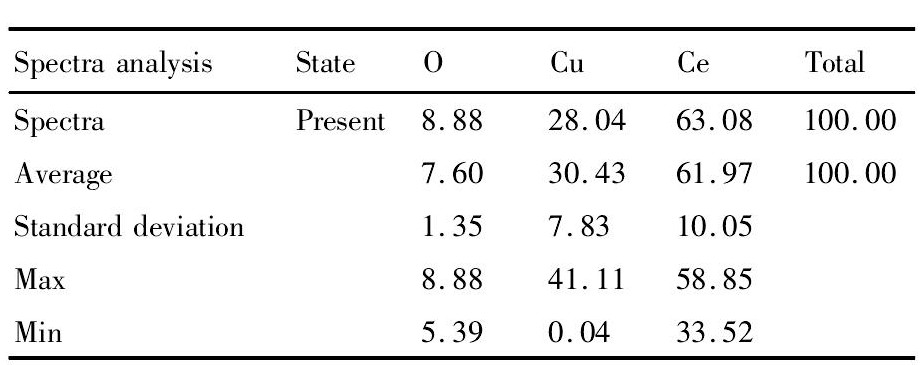
表3 显示结果 (%, 质量分数) Table 3 Analysis results (%, mass fraction)
3 结论
1.在80℃时离子液体[BMIM]PF6的电化学窗口为4.0 V, 其电导率随着温度的升高而增大。[BMIM]PF6-Ce Cl3-EG的电导率随温度的升高而增大, 并且相同温度下[BMIM]PF6-Ce Cl3-EG的电导率大于[BMIM]PF6的电导率。
2.80℃时, 在[BMIM]PF6-Ce Cl3-EG电解液中Ce (III) 还原成Ce (0) 的过程是受扩散控制的不可逆过程, 阴极传递系数为 (a) 0.05, 扩散系数D0为2.45×10-6cm2·s-1。
3.在80℃, 沉积时间为30 min时, 在[BMIM]PF6-Ce Cl3-EG电解体系液中Ce (III) 在Cu表面上的电沉积镀层为颗粒状, 颗粒的体积随着沉积电势的负移而增大。
4.在[BMIM]PF6-Ce Cl3-EG电解体系液中Ce (III) 在Cu表面上的电沉积镀层为纯金属Ce和其氧化物。
参考文献



